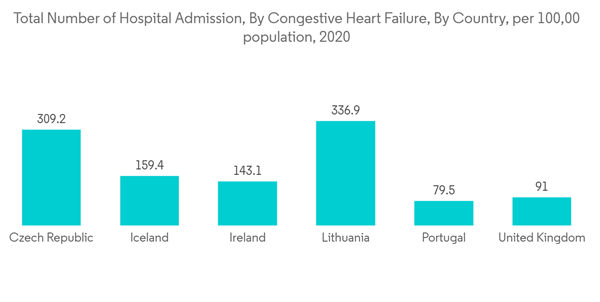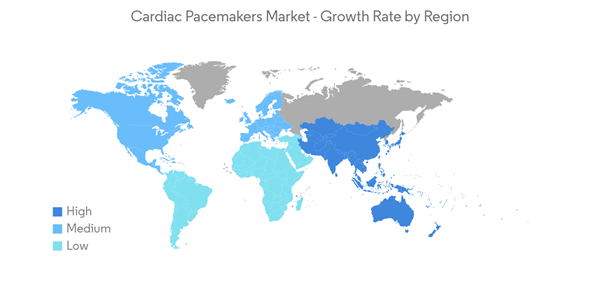The Global Cardiac Pacemakers Market size is estimated at USD 4.68 billion in 2024, and is expected to reach USD 5.53 billion by 2029, growing at a CAGR of 3.43% during the forecast period (2024-2029).
The COVID-19 pandemic slowed the growth of the cardiovascular market. Due to the high rate of infection and the lack of treatment, many countries are suffering and continue to carry a heavy burden on their economies and healthcare systems. Many countries had previously shut down and stopped trading with other countries due to travel restrictions, leading to a slowdown for large companies worldwide. The American College of Surgeons and the American Society of Anesthesiologists recommended a continuous reduction in the rate of new cases of COVID-19 14 days before the resumption of special surgery. Also, according to a research article published in Case Reports in Cardiology, 2020, temporary patients undergoing pacemaker transfusion are 2.5 times more likely to acquire COVID-19 infection before the first pacemaker (PPM) injection. Therefore, research suggested that the selection of temporary cardiac care providers increased the risk of long-term associated complications and transmission of infection to healthcare workers. Therefore, the market is expected to see negative growth due to the high risk associated with heart surgery during COVID-19.
The escalation of lifestyle-related disruptions, favorable reimbursement status, increased adult populations, and technological advances are expected to boost the market studied.
According to data from the World Population Prospects: Highlights 2020, approximately 1.5 billion people worldwide will be over 65 by 2050, up from 727 million by 2020. One in four people in Europe and North America will be 65 years or older by 2050. From 143 million in 2019 to 426 million by 2050, the number of people aged 80 and over is expected to triple. Pacing treatment is usually done to treat severe arrhythmia. According to a research article titled "Pacemaker Treatment for Older Patients: Survival and Specific Predicting Limits for One-Centered Experience", published in 2019, the number of older patients receiving pacemakers is growing, and European guidelines do not consider any age limits to installing a pacemaker.
In addition, according to a World Health Organization article published in July 2021, an estimated 17.9 million people worldwide die from heart disease every year, representing 31% of deaths globally, and 85% of these deaths are mainly caused by heart disease and stroke. Therefore, the growing burden of heart disease worldwide and technological advancements in the development of novel pacemakers are expected to boost the cardiovascular market during the forecast period.
Reduced postoperative complications can cause partial growth. Biventricular pacemakers are expected to gain momentum due to the presence of multiple tracks. These devices can be installed in multiple locations as they consist of three tracks installed in the left and right atrium and the ventricle. These biventricular pacemakers are very useful due to their many benefits in helping with conditions such as ventricular dyssynchrony.
Additionally, growing technological advances and product approvals drive the segment's growth. For example, in July 2020, Abbott Laboratories received approval from the US Food and Drug Administration for its Gallant line, which includes an implanted cardioverter-defibrillator and a cardiac resynchronization therapy defibrillator with Bluetooth technology. Advanced features in pacemaker technology, such as remote data tracking devices, secure magnetic resonance imaging (MRI) devices, and data recording functionality, boost the segment's growth.
Therefore, implanted cardiac pacemakers are expected to show significant growth during the prognosis and boost the market.
According to the report titled "The number of older people will hit the US economy 'like a' brick '- US trade secretary", published in April 2021, about 16.5% of the US population, or 54 million, were over the age of 65 by 2020. By 2030, this number will rise to 74 million. The number of people over the age of 85 who are at risk of developing heart disease is expected to increase significantly. In addition, according to the American Heart Association's figures published in January 2019, nearly half of the American population has some form of heart disease, including high blood pressure. The spread of heart diseases creates a need for cardiovascular equipment, monitoring, and diagnostic equipment. Therefore, there is a great need for better treatment with advanced medical devices, which may drive the studied market.
In addition, the United States has become home to many key players, such as Abbott Laboratories and Boston Scientific Corporation, which play a key role in the development, construction, and marketing of cardiac suppliers. For example, in September 2019, EBR Systems Inc. acquired the US FDA Breakthrough Device Designation for WiSE (Wireless Stimulation Endocardially) CRT System to treat heart failure. Therefore, the increasing rate of heart diseases in the United States and the introduction of new products by key players are expected to boost the market during the forecast period.
Arrhythmia affects all age groups, but the risk of developing atrial fibrillation (AF) increases with age. As per Heart Disease and Stroke Statistics 2019, the risk of long-term atrial fibrillation is estimated to be 1 in 3 white people in the United States. In addition, the use of alcohol, tobacco, sedentary lifestyles, and certain over-the-counter drugs may increase the risk of arrhythmia.
Therefore, the North American cardiovascular market is expected to witness significant growth during the forecast period due to such factors.
This product will be delivered within 2 business days.
The COVID-19 pandemic slowed the growth of the cardiovascular market. Due to the high rate of infection and the lack of treatment, many countries are suffering and continue to carry a heavy burden on their economies and healthcare systems. Many countries had previously shut down and stopped trading with other countries due to travel restrictions, leading to a slowdown for large companies worldwide. The American College of Surgeons and the American Society of Anesthesiologists recommended a continuous reduction in the rate of new cases of COVID-19 14 days before the resumption of special surgery. Also, according to a research article published in Case Reports in Cardiology, 2020, temporary patients undergoing pacemaker transfusion are 2.5 times more likely to acquire COVID-19 infection before the first pacemaker (PPM) injection. Therefore, research suggested that the selection of temporary cardiac care providers increased the risk of long-term associated complications and transmission of infection to healthcare workers. Therefore, the market is expected to see negative growth due to the high risk associated with heart surgery during COVID-19.
The escalation of lifestyle-related disruptions, favorable reimbursement status, increased adult populations, and technological advances are expected to boost the market studied.
According to data from the World Population Prospects: Highlights 2020, approximately 1.5 billion people worldwide will be over 65 by 2050, up from 727 million by 2020. One in four people in Europe and North America will be 65 years or older by 2050. From 143 million in 2019 to 426 million by 2050, the number of people aged 80 and over is expected to triple. Pacing treatment is usually done to treat severe arrhythmia. According to a research article titled "Pacemaker Treatment for Older Patients: Survival and Specific Predicting Limits for One-Centered Experience", published in 2019, the number of older patients receiving pacemakers is growing, and European guidelines do not consider any age limits to installing a pacemaker.
In addition, according to a World Health Organization article published in July 2021, an estimated 17.9 million people worldwide die from heart disease every year, representing 31% of deaths globally, and 85% of these deaths are mainly caused by heart disease and stroke. Therefore, the growing burden of heart disease worldwide and technological advancements in the development of novel pacemakers are expected to boost the cardiovascular market during the forecast period.
Cardiac Pacemakers Market Trends
Implantable Cardiac Pacemakers Segment Captures the Largest Market Share and is Expected to Grow with a Lucrative Rate
The implanted cardiac pacemakers hold taken the largest market share. They are expected to register the most profitable growth rate during the forecast period. Installed pacemakers are of three main types, namely single chamber, dual-chamber, and biventricular pacemakers.Reduced postoperative complications can cause partial growth. Biventricular pacemakers are expected to gain momentum due to the presence of multiple tracks. These devices can be installed in multiple locations as they consist of three tracks installed in the left and right atrium and the ventricle. These biventricular pacemakers are very useful due to their many benefits in helping with conditions such as ventricular dyssynchrony.
Additionally, growing technological advances and product approvals drive the segment's growth. For example, in July 2020, Abbott Laboratories received approval from the US Food and Drug Administration for its Gallant line, which includes an implanted cardioverter-defibrillator and a cardiac resynchronization therapy defibrillator with Bluetooth technology. Advanced features in pacemaker technology, such as remote data tracking devices, secure magnetic resonance imaging (MRI) devices, and data recording functionality, boost the segment's growth.
Therefore, implanted cardiac pacemakers are expected to show significant growth during the prognosis and boost the market.
North America Captured the Largest Market Share, and May Continue to Retain its Dominance During the Forecast Period
North America emerged as the largest regional market in terms of revenue. The high prevalence of cardiovascular disease, high obesity, and favorable revenues are key factors contributing to its huge market size.According to the report titled "The number of older people will hit the US economy 'like a' brick '- US trade secretary", published in April 2021, about 16.5% of the US population, or 54 million, were over the age of 65 by 2020. By 2030, this number will rise to 74 million. The number of people over the age of 85 who are at risk of developing heart disease is expected to increase significantly. In addition, according to the American Heart Association's figures published in January 2019, nearly half of the American population has some form of heart disease, including high blood pressure. The spread of heart diseases creates a need for cardiovascular equipment, monitoring, and diagnostic equipment. Therefore, there is a great need for better treatment with advanced medical devices, which may drive the studied market.
In addition, the United States has become home to many key players, such as Abbott Laboratories and Boston Scientific Corporation, which play a key role in the development, construction, and marketing of cardiac suppliers. For example, in September 2019, EBR Systems Inc. acquired the US FDA Breakthrough Device Designation for WiSE (Wireless Stimulation Endocardially) CRT System to treat heart failure. Therefore, the increasing rate of heart diseases in the United States and the introduction of new products by key players are expected to boost the market during the forecast period.
Arrhythmia affects all age groups, but the risk of developing atrial fibrillation (AF) increases with age. As per Heart Disease and Stroke Statistics 2019, the risk of long-term atrial fibrillation is estimated to be 1 in 3 white people in the United States. In addition, the use of alcohol, tobacco, sedentary lifestyles, and certain over-the-counter drugs may increase the risk of arrhythmia.
Therefore, the North American cardiovascular market is expected to witness significant growth during the forecast period due to such factors.
Cardiac Pacemakers Industry Overview
The cardiac pacemakers market is moderately competitive and consists of a few dominant players, including Abbott Laboratories (ST. Jude Medical), Medtronic PLC, Boston Scientific Corporation, Biotronik SE & Co. KG, and Lepu Medical Co. Ltd.Additional Benefits:
- The market estimate (ME) sheet in Excel format
- 3 months of analyst support
This product will be delivered within 2 business days.
Table of Contents
1 INTRODUCTION
4 MARKET DYNAMICS
5 MARKET SEGMENTATION (Market Size by Value - USD million)
6 COMPETITIVE LANDSCAPE
Companies Mentioned (Partial List)
A selection of companies mentioned in this report includes, but is not limited to:
- Abbott Laboratories (ST Jude Medical)
- Biotronik SE & Co. KG
- Boston Scientific Corporation
- Lepu Medical Co. Ltd
- Medico SpA
- Medtronic PLC
- Oscor Inc.
- Osypca Medical GmbH
- Zoll Medical Corporation
- MicroPort Scientific Corporation
- Cook Medical
- Pacetronix
- Sorin Group
Methodology

LOADING...










